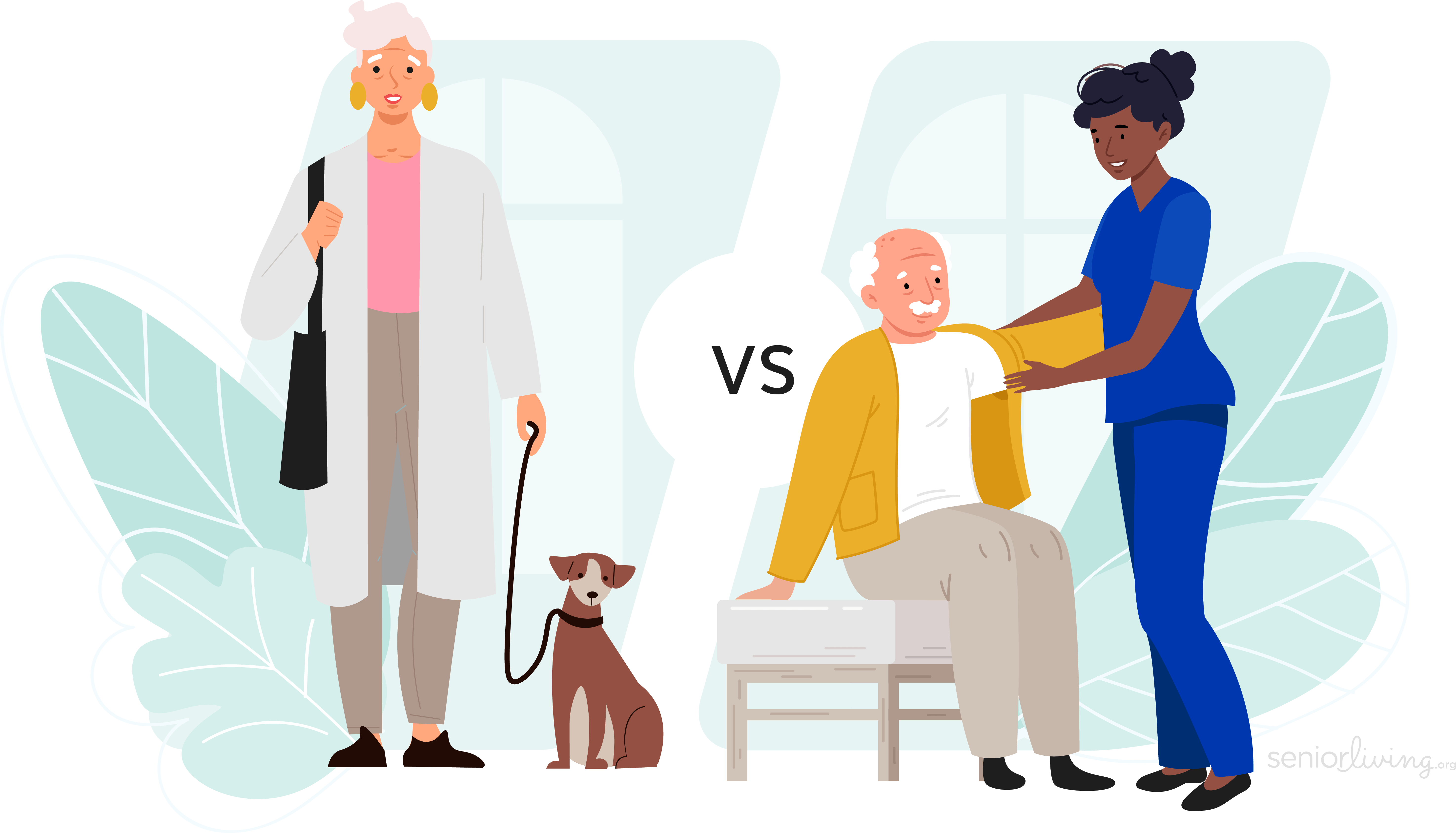Assisted Living vs. Independent Living
Assisted living allows older adults to receive assistance with daily tasks while still maintaining some independence. Independent living is designed for those who don’t need care and want to live among their peers.
SeniorLiving.org is supported by commissions from providers listed on our site. Read our Editorial Guidelines
Find Assisted Living or Independent Living Near You
Join 200,448 Families Who've Found Assisted Living Communities on SeniorLiving.org.
Or Call: (855) 241-1699Find Assisted Living or Independent Living Near You
Assisted Living vs. Independent Living: Key Takeaways
- Assisted and Independent Living are two options for housing as we get older with some key differences.
- Assisted living is for those who need assistance with activities of daily living, but still want to maintain a level of independence. It’s usually more expensive than independent living. Read our guide to assisted living to learn more and decide if it’s the best fit for your needs.
- Independent living communities attract older adults in pretty good health who don’t need personal care services. They no longer want to maintain a home’s upkeep but rather live in communities with their peers, those who are 55+.
As people age, they might find themselves faced with the decision of where to live. The topic becomes even more pressing after the death of a spouse or a medical scare. As some older adults prepare for a change in living accommodations, an illness or disability might translate to a need for more assistance. Living alone might no longer be an option. Others might be in good health but no longer need a big house, and prefer to live an active life in a community with others who are independent.
These are just some of the many reasons that older adults consider assisted living and independent living. It’s important to know the difference between these two common entry levels of senior living communities as you contemplate your next move.
In this guide, we’ll compare independent and assisted living so you can make the choice that’s best for you and your needs.
Our free housing and care finder uses your unique needs to curate a list of the best options in your area.
Table of Contents
Independent Living
Some older adults can’t afford to live in their own home or the maintenance has gotten to be too much. Some are lonely and want the social interactions that are available in a senior community. For these and other reasons, older adults choose to move into an independent living community.
Independent living communities offer an active lifestyle with opportunities to connect with others in the same age group who share common interests. Most independent living facilities offer loads of social activities. You’ll probably find yoga classes, game nights, and pickleball lessons here. Amenities on-site often include laundry facilities, beauty salons, and fitness centers. Light housekeeping, meal plans, and transportation to doctor’s appointments are usually offered at an added cost.
Independent living communities don’t offer personal care or medical services, but might contract out for those. These communities offer seniors an opportunity to enjoy their retirement in their own private living spaces without the responsibilities of managing a home. Their living spaces might include more than one bedroom as well as spacious kitchens and living rooms where they can host guests. Regular events and activities help residents socialize and build close relationships.
Interesting Information: More and more independent and assisted living facilities have become pet-friendly. While science has shown that pets reduce our stress level, a recent article in AARP says owning a pet (especially for more than five years) is now linked to delayed aging of the brain in seniors.1 A University of Michigan study showed slower cognitive decline in those over 65 who had furry friends.2
Independent living centers afford you or your loved one the most independence and are the least restrictive option of all senior community options. The National Council on Aging says these centers are less regulated, but they’re also usually less expensive. Assisted living is the next level up. It offers more support and assistive services.
Costs and Paying for Care
The median cost of independent living in 2024 is an estimated $36,780 per year. Medicare and Medicare Advantage plans typically will not cover independent living costs. Medicaid might cover some costs, but eligibility requirements vary by state
Assisted Living
Assisted living communities are regulated by the state, so they will vary in what they offer, depending on where you live. Most facilities, however, will offer residents a private or semi-private living space, housekeeping, meals and snacks, and crucial assistance with their daily tasks and medical needs. Social activities at assisted living centers might include bingo, sing-alongs, walks, and chair yoga.

SeniorLiving.org is supported by commissions from providers listed on our site. Read our Editorial Guidelines
Staff is available 24/7 to help residents with healthcare needs, including scheduling doctor’s visits and transportation to and from their appointments. Seniors at assisted living centers often need help with activities of daily living, such as bathing, toileting, and moving in and out of bed. Others may be living with chronic health conditions such as heart disease or diabetes. Still others may be facing cognitive decline associated with Alzheimer’s disease or another form of dementia. Although they require assistance, residents of assisted living facilities typically don’t require 24-hour skilled nursing care as provided by nursing homes.
What is reassuring to residents and their families is that assisted living communities tend to staff one or more full-time medical personnel, such as certified nursing assistants trained in the needs of older adults, registered nurses (RNs) or licensed practical nurses (LPNs), or doctors, all available to provide emergency medical care if needed.
Some assisted living communities also have specialized memory care units that provide expert care to those who have more advanced cognitive issues. Sometimes set up as a dedicated wing within the community, these units offer advanced security measures such as secured entrances/exits and extra surveillance equipment.
Be Aware: Keep in mind that according to the National Center for Assisted Living (NCAL), 87 percent of assisted living providers are still having difficulty hiring staff. When you visit facilities, you probably will want to know the impact of any employee shortage on the center you are interested in.3
Watch our video below to learn more about assisted living.

Costs and Paying for Care
The median cost of assisted living in 2025 is estimated to be $68,110 per year. Residents usually pay through long-term care insurance or private savings. Unfortunately, Medicare does not cover expenses for assisted living and Medicare Advantage plans offer limited benefits. Medicaid offers waivers to cover the costs of some services. Policies are more likely to cover the medical services aspect of your residency, but by and large, not the remainder of costs. Because assisted living offers more care and services for residents, it is typically more expensive.
Choosing Between Independent Living and Assisted Living
Trying to find the best living option for yourself or an aging family member can seem overwhelming at times, but having the information you need at your fingertips can make decision-making easier. Those who are making their first move into a senior living community often compare independent living vs. assisted living options.
The chart below clarifies the differences between independent and assisted living communities:
| Independent living communities | Assisted living communities | |
|---|---|---|
| Living accommodations | Accommodations can range widely and include cottages, townhomes, condos, or apartments. | Private or semi-private accommodations generally consist of an apartment with a small kitchen, living area, and private bed and bath. |
| Meals | Up to three meals a day through meal plans at extra cost. Multiple dining options or onsite restaurants may also be available at extra cost. | Three meals are served in a communal dining area, usually at no additional cost, as part of a package. |
| Housekeeping services | Weekly housekeeping services may be offered, usually at an extra cost. | More comprehensive housekeeping and laundry services are generally included at no additional cost. |
| Caregiving services | Specialized care like physical therapy or a home health aide can be arranged as supplemental care through a third party at an additional cost. | Caregivers are available around the clock. Specialized or one-on-one care has to be arranged as supplemental care through a third party at an additional cost. |
| Medication management | Medication management may or may not be provided at an extra cost. | Medication management is provided at no additional cost. |
| Medical personnel available | Medical personnel may or may not be provided at extra cost. | Full-time medical personnel are on site or available via phone at all times at no additional cost. |
| Assistance with ADLs | May have partnerships with third party providers to help with ADLs, but it will be at an extra cost. | Assistance with ADLs is available around the clock and at no additional cost. |
| Activities | Social outings and events are planned. Some communities have a full calendar of activities, usually at no cost. | Various activities are scheduled daily (usually within the facility) to keep the residents busy throughout the day at no additional cost. |
| Transportation | Transportation to and from doctor’s appointments and other errands may be available, but at an extra cost. | Transportation to and from doctor’s appointments and other errands is included at no additional cost. |
| Payment sources | Mostly private pay. Some federal funding may be available through Section 202 for low-income seniors, but waiting lists are long. | Mostly private pay. Medicare considers the care provided as custodial care, so it does not pay. It may be covered by long-term care insurance, private savings, Medicaid, and veterans benefits. |
| Average price range | Median cost is $3,065 per month. | Median cost is $5,511 per month.4 Memory care will run substantially higher. |
| Other names for these communities | Retirement Communities, Retirement Villages, 55+ Communities, Senior Apartments, and Congregate Care Communities | Assisted Care Communities and Personal Care Homes |
The most significant difference between independent living and assisted living within a larger senior care community is that residents in assisted living have access to full-time medical and custodial care as part of their package. Additionally, meals and housekeeping services are generally included in the cost of care for assisted living, whereas they are likely to cost extra at independent living locations.
Although assisted living communities assist with ADLs, they do not provide intensive hands-on care or skilled nursing care. Seniors with serious physical or mental ailments that require more intensive care should look at a nursing home or skilled nursing community to better suit their needs. Residents may also opt to arrange for this care through a third party at an additional cost and remain in the assisted living community.
In the end, the choice between independent living and assisted living is often determined by the needs of the senior and the cost that the senior and their family can afford. Many senior living communities offer both independent and assisted living. Some also offer higher levels of care, such as memory care and skilled nursing. Knowing that care needs often change, it’s a good idea to take this into consideration as you make your decision and visit facilities.
How to Make a Decision Between Independent and Assisted Living
If independent living and assisted living are both possibilities for you or a loved one, we suggest you take the following actions:
- Research further.
- Talk to family and friends. See if they have any insights and recommendations about the matter.
- Ask your health care provider to guide you about which is best and to point you to excellent centers they know about.
- If you’re thinking of an assisted living community, you can search our assisted living directory.
Once you have decided about one or the other, narrow down your choices to a few communities. Then tour the communities in person. Look around to see if residents are engaged. Note if the staff seems warm and caring. Pay attention to the facilities. Is everything clean, organized, and in working order? Does the environment feel safe and like the right place for you or your loved one?
Here are suggested questions to ask:
- Which services are included in the monthly rate?
- Which services can be obtained at an additional fee?
- What policies and procedures do you have about accessing health care and medical services?
- What is your policy regarding an emergency?
- Regarding family involvement and communication, how do you ensure the family is kept up-to-date about their loved one?
- What is the staff-to-resident ratio at this facility?
- What kind of training does the staff get?
- What care and services are available if the resident’s needs change?
Based on the above information, you can feel more confident now. You know what’s important to consider and what to look for. So, when it comes to choosing between an assisted living or independent living facility, you are well on your way.
AARP. (2022). Pet Ownership May Delay Cognitive Decline in Older Adults.
EurekAlert! (2022). Do pets have a positive effect on your brain health?
AHCA NCAL. (2022). Survey: More Than Half of Assisted Living Providers Say Their Overall Workforce Situation Has Worsened.
CareScout. (2025). Calculate the cost of long-term care near you.




